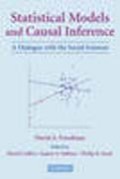
Statistical models and causal inference: a dialogue with the social sciences
Freedman, David A.
Collier, David
Sekhon, Jasjeet
Stark, Philip B.
David A. Freedman presents here a definitive synthesis of his approach to causal inference in the social sciences. He explores the foundations and limitations of statistical modeling, illustrating basic arguments with examples from political science, public policy, law, and epidemiology. Freedman maintains that many new technical approaches to statistical modeling constitute not progress, but regress. Instead, he advocates a 'shoe leather' methodology, which exploits natural variation to mitigate confounding and relies on intimate knowledge of the subject matter to develop meticulous research designs and eliminate rival explanations. When Freedman first enunciated this position, he was met with scepticism, in part because it was hard to believe that a mathematical statistician of his stature would favor 'low-tech' approaches. But the tide is turning. Many social scientists now agree that statistical technique cannot substitute for good research design and subject matter knowledge. This book offers an integrated presentation of Freedman's views. INDICE: Editors' introduction: inference and shoe leather; Part I. Statistical Modeling: Foundations and Limitations: 1. Some issues in the foundations of statistics: probability and model validation; 2. Statistical assumptions asempirical commitments; 3. Statistical models and shoe leather; Part II. Studies in Political Science, Public Policy, and Epidemiology: 4. Methods for Census 2000 and statistical adjustments; 5. On 'solutions' to the ecological inference problem; 6. Rejoinder to King; 7. Black ravens, white shoes, and case selection: inference with categorical variables; 8. What is the chance of an earthquake?; 9. Salt and blood pressure: conventional wisdom reconsidered; 10. The Swine Flu vaccine and Guillain-Barre Syndrome: relative risk and specific causation; 11. Survival analysis: an epidemiological hazard?; Part III. New Developments: Progress or Regress?: 12. On regression adjustments in experiments with several treatments; 13. Randomization does not justify logistic regression; 14. The grand leap; 15. On specifying graphical models for causation, and the identification problem; 16. Weighting regressions by propensity scores; 17. Onthe so-called 'Huber sandwich estimator' and 'robust standard errors'; 18. Endogeneity in probit response models; 19. Diagnostics cannot have much power against general alternatives; Part IV. Shoe Leather, Revisited: 20. On types of scientific inquiry: the role of quantitative reasoning
- ISBN: 978-0-521-12390-7
- Editorial: Cambridge University
- Encuadernacion: Rústica
- Páginas: 416
- Fecha Publicación: 23/11/2009
- Nº Volúmenes: 1
- Idioma: Inglés
